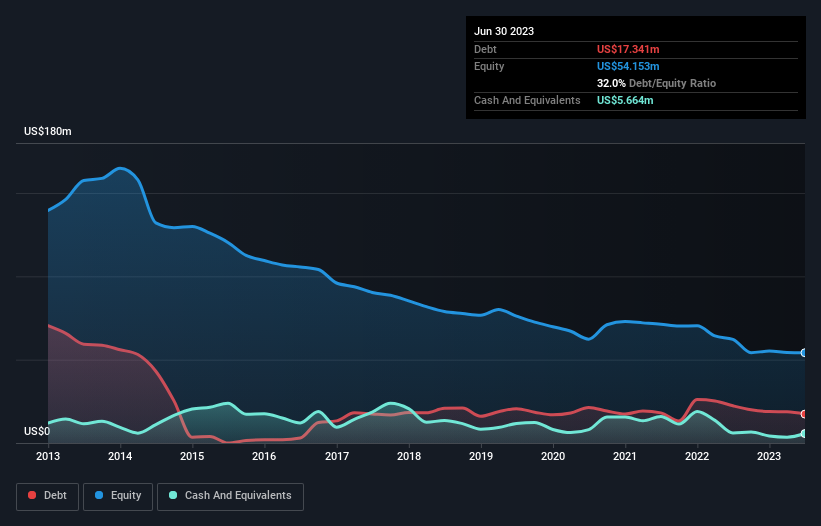Legendary fund manager Li Lu (who Charlie Munger backed) once said, 'The biggest investment risk is not the volatility of prices, but whether you will suffer a permanent loss of capital.' So it might be obvious that you need to consider debt, when you think about how risky any given stock is, because too much debt can sink a company. We note that Orvana Minerals Corp. (TSE:ORV) does have debt on its balance sheet. But the real question is whether this debt is making the company risky.
Why Does Debt Bring Risk?
Debt is a tool to help businesses grow, but if a business is incapable of paying off its lenders, then it exists at their mercy. If things get really bad, the lenders can take control of the business. However, a more common (but still painful) scenario is that it has to raise new equity capital at a low price, thus permanently diluting shareholders. Of course, plenty of companies use debt to fund growth, without any negative consequences. When we examine debt levels, we first consider both cash and debt levels, together.
Check out our latest analysis for Orvana Minerals
How Much Debt Does Orvana Minerals Carry?
As you can see below, Orvana Minerals had US$17.3m of debt at June 2023, down from US$22.3m a year prior. However, because it has a cash reserve of US$5.66m, its net debt is less, at about US$11.7m.

How Strong Is Orvana Minerals' Balance Sheet?
The latest balance sheet data shows that Orvana Minerals had liabilities of US$44.6m due within a year, and liabilities of US$31.4m falling due after that. Offsetting this, it had US$5.66m in cash and US$1.62m in receivables that were due within 12 months. So its liabilities total US$68.8m more than the combination of its cash and short-term receivables.
This deficit casts a shadow over the US$15.6m company, like a colossus towering over mere mortals. So we'd watch its balance sheet closely, without a doubt. At the end of the day, Orvana Minerals would probably need a major re-capitalization if its creditors were to demand repayment. There's no doubt that we learn most about debt from the balance sheet. But you can't view debt in total isolation; since Orvana Minerals will need earnings to service that debt. So when considering debt, it's definitely worth looking at the earnings trend. Click here for an interactive snapshot.
In the last year Orvana Minerals wasn't profitable at an EBIT level, but managed to grow its revenue by 5.2%, to US$97m. We usually like to see faster growth from unprofitable companies, but each to their own.
Caveat Emptor
Importantly, Orvana Minerals had an earnings before interest and tax (EBIT) loss over the last year. Its EBIT loss was a whopping US$4.3m. If you consider the significant liabilities mentioned above, we are extremely wary of this investment. That said, it is possible that the company will turn its fortunes around. Nevertheless, we would not bet on it given that it lost US$6.6m in just last twelve months, and it doesn't have much by way of liquid assets. So we think this stock is quite risky. We'd prefer to pass. The balance sheet is clearly the area to focus on when you are analysing debt. However, not all investment risk resides within the balance sheet - far from it. We've identified 1 warning sign with Orvana Minerals , and understanding them should be part of your investment process.
If you're interested in investing in businesses that can grow profits without the burden of debt, then check out this free list of growing businesses that have net cash on the balance sheet.
New: AI Stock Screener & Alerts
Our new AI Stock Screener scans the market every day to uncover opportunities.
• Dividend Powerhouses (3%+ Yield)
• Undervalued Small Caps with Insider Buying
• High growth Tech and AI Companies
Or build your own from over 50 metrics.
Have feedback on this article? Concerned about the content? Get in touch with us directly. Alternatively, email editorial-team (at) simplywallst.com.
This article by Simply Wall St is general in nature. We provide commentary based on historical data and analyst forecasts only using an unbiased methodology and our articles are not intended to be financial advice. It does not constitute a recommendation to buy or sell any stock, and does not take account of your objectives, or your financial situation. We aim to bring you long-term focused analysis driven by fundamental data. Note that our analysis may not factor in the latest price-sensitive company announcements or qualitative material. Simply Wall St has no position in any stocks mentioned.
About TSX:ORV
Orvana Minerals
A mining and exploration company, engages in the evaluation, development, and mining of gold, copper, silver, and other precious and base metal deposits.
Mediocre balance sheet and slightly overvalued.
Market Insights
Community Narratives



